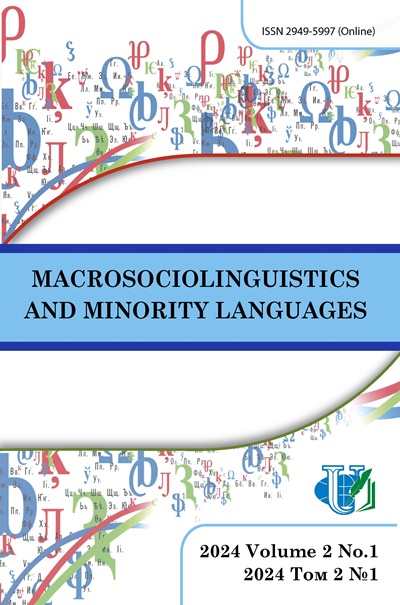Dynamics of language endangerment: a comparison of three northern tungusic lects spoken in the Russian Federation
- 作者: Pakendorf B.1,2
-
隶属关系:
- Linguistic Diversity and its Sources Laboratory, French National Centre for Scientific Research
- Lyon 2 University
- 期: 卷 2, 编号 1 (2024)
- 页面: 102-106
- 栏目: SCIENTIFIC EVENTS. REVIEWS. REVIEWS
- URL: https://macrosociolingusictics.ru/MML/article/view/44822
- DOI: https://doi.org/10.22363/2949‑5997‑2024‑2‑1‑102‑106
- EDN: https://elibrary.ru/LSBGNH
- ID: 44822
如何引用文章
全文:
详细
Most languages spoken by the so-called "small-numbered peoples of the North" are currently highly endangered or extinct (Janhunen, 2010, Bromham et al., 2022). Yet there are big individual differences in vitality between languages and even between dialects of individual languages. For instance, the Samoyedic language Tundra Nenets - even though "definitely an endangered language" - is still spoken by approximately 20,000 individuals, albeit with big differences in vitality between regional varieties (Nikolaeva, 2014: 5-6). In contrast, the Tungusic language Negidal is spoken by only a handful of elderly women, and it is only the Upper dialect of Negidal that is still spoken, while the last speakers of the Lower dialect passed away in 2010-2020 (Pakendorf, Aralova, 2018). Factors that have an impact on language vitality at a global level are the size of the speech community (number of L1 speakers), the extent of connectedness of the language community to other communities and urban centres, and the level of formal schooling, but regional specificities can have a significant impact on differences in vitality and endangerment (Bromham et al., 2022).Differences in language vitality are also observable in three Northern Tungusic lects that I have been studying since 2007: the Lamunkhin dialect of Even spoken in Central Yakutia, the Bystraja dialect of Even spoken in Central Kamchatka, and Negidal, spoken in the Lower Amur region of the Russian Far East (see Appendix 1). All three communities have undergone Russian colonization in 17th century and the sociopolitical changes associated with the Soviet era (cf. Sablin, Savelyeva, 2011), and all three are relatively small, numbering only several hundred individuals during most of the 20th century (Filippova, 2017; Kirillova, 2012: 117; Pevnov, Khasanova, 2006: 451-452). And yet, while all three lects are definitely endangered, they are at different stages of the endangerment scale (Grenoble, Whaley, 2011: 40): Negidal is nearly extinct (Pakendorf, Aralova, 2018: 11), Bystraja Even is moribund, and Lamunkhin Even is disappearing. In this abstract, I discuss the factors that have shaped the current levels of language vitality among these lects and the reasons for the observed differences.
全文:
The Appendix contains photographs taken by the author of the publication on the expeditions on the basis of which this extended abstract was written. Рис. 1. Село Себян-Кюёль в Кобяйском улусе Республики Саха (Якутия, Россия) Источник: сделанно Б. Пакендорф в экспедициях, по материалам которых написана данная расширенная аннотация. Figure 1. Sebyan-Kyuyol, rural locality in Kobyaysky District in the Sakha Republic (Yakutia, Russia) Source: taken by B. Pakendorf on the expeditions on the basis of which this extended abstract was written. Рис. 2. Село Эссо в Камчатском крае России, административный центр Быстринского района Источник: сделанно Б. Пакендорф в экспедициях, по материалам которых написана данная расширенная аннотация. Figure 2. Esso, a village in Kamchatka Krai in Russia, administrative center of Bystrinsky District作者简介
Brigitte Pakendorf
Linguistic Diversity and its Sources Laboratory, French National Centre for Scientific Research; Lyon 2 University
编辑信件的主要联系方式.
Email: brigitte.pakendorf@cnrs.fr
ORCID iD: 0000-0002-0816-9930
Senior scientist (Directrice de recherche) at the research unit Dynamique du Langage of the CNRS (Centre national de la recherche scientifique) & Université Lumière Lyon 2
Lyon, France参考
- Bromham, L., Dinnage, R., Skirgård, H., Andrew, R., Marcel, C., Felicity, M., Simon, G., & Xia, H. (2022). Global predictors of language endangerment and the future of linguistic diversity. Nature Ecology & Evolution, 6(2), 163-173. https://doi.org/10.1038/s41559-021-01604-y
- Filippova, V.V. (2017). Lamunkhinsky Evens: Population and settlement in 20th-21st centuries. Naučnyj dialog, (9), 202-213. (In Russ.). https://doi.org/10.24224/2227-1295-2017-9-202-213
- Grenoble, L.A., & Whaley, L.J. (2011). The case for dialect continua in Tungusic: plural morphology. Current Trends in Caucasian, East European and Inner Asian Linguistics: Papers in Honor of Howard I. Aronson. John Benjamins Publishing Company. Amsterdam. P. 97-122. https:// doi.org/10.1075/cilt.246.10gre
- Janhunen, J. (2010). North-east Asia. In C. Moseley (ed.). Atlas of the World’s Languages in Danger. Paris: UNESCO. Р. 47-59
- Kirillova, A.I. (2012). Bystrinskie eveny: istoriya izucheniya i vydeleniya gruppy [Bystrinsky Evens: history of study and identification of the group]. Vestnik arxe-ologii, antropologii i ètnografii, (1), 113-120. (In Russ.)
- Nikolaeva, I. (2014). A grammar of Tundra Nenets. Berlin, Boston: de Gruyter Mouton. https:// doi.org/10.1515/9783110320640
- Pakendorf, B., & Aralova, N. (2018). The endangered state of Negidal: A field report. Language Documentation and Conservation, (12), 1-14
- Pevnov, A.M., & Khasanova, M.M. (2006). Negidal’tsy i negidal’skii yazyk (obshchie svedeniya, zvukovoi stroi, imennye chasti rechi) [Negidals and the Negidal language (general information, sound structure, nominal parts of speech)]. Acta Linguistica Petropolitana, 2(1), 447-542. (In Russ.)
- Sablin, I., & Savelyeva, M. (2011). Mapping indigenous Siberia: Spatial changes and ethnic realities, 1900-2010. Settler Colonial Studies, 1(1), 77-110. https://doi.org/10.1080/2201473X. 2011.10648802
补充文件







